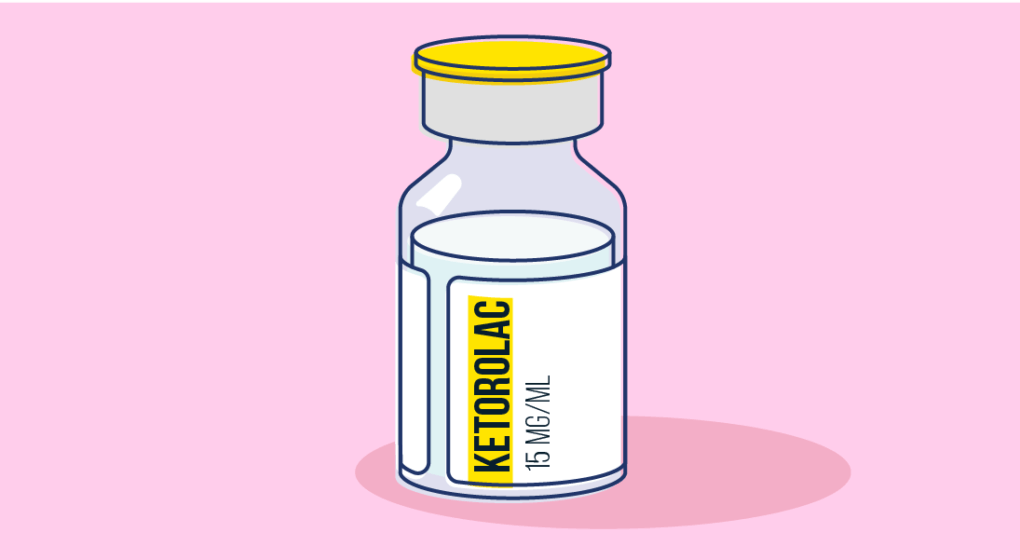
Ketorolac is a type of drug called a non-steroidal anti-inflammatory drug (NSAID), works to reduce inflammation by stopping the production of compounds called prostaglandins in the body. These compounds have a number of effects in the body, including to cause inflammation.
Brand Names and Doses
Ketorolac is the generic name of the drug, which is the name of the active component that has an effect on your body. You may also know it better by the brand names, Toradol or Ketoral, which are the names given to the medication made by each pharmaceutical company for marketing purposes.
Toradol is available as an oral tablet in a dose of 10 mg, or as an injection for hospital use. Ketoral is only available as an injection.
What type of drug is it?
Ketorolac is a type of drug known as a non-steroidal anti-inflammatory drug (NSAID), which is a group of drugs that all work in a similar way. Other examples of NSAIDs include:
Ketorolac is a nonselective NSAID, which means that it blocks both COX-1 and COX-2 to stop the production of more types of prostaglandins than some other NSAIDs. This means that it is more likely to cause side effects due to the action of the other prostaglandins that is reduced.
Additionally, you body is very efficient at eliminating ketorolac from the body, so you need to take multiple doses throughout the day in order for it to have a continuous effect. In fact, you would need to take 4 doses per day to provide continuous relief of pain and inflammation and this is why alternative drugs that work in a similar way are usually recommended instead - it’s easier to take 1 tablet a day than 4.
What is Ketorolac used for?
Ketorolac is usually used to help relieve symptoms of mild to moderate pain and inflammation after surgery.
Unlike other NSAID medications, it is not often used to reduce pain and inflammation of chronic health conditions such as rheumatoid arthritis because it has inconvenient dosing. You are more likely to accidentally forget a dose if you need to take 4 tablets each day.
How does it work?
Ketorolac works by inhibiting COX-1 and COX-2, which are needed to produce the different prostaglandins in your body. You have many different types of prostaglandins in your body, and there are some in almost every tissue of your body. They each have different effects, such as to cause:
Inflammation in the tissues in your body
Relaxation and widening of your blood vessels
Aggregation of the platelets in your blood to form a clot
Ketorolac has a general effect on almost all the prostaglandins because it blocks both COX-1 and COX-2 from producing prostaglandins in your body. This means that it can reduce all of the usual effects prostaglandins. We want it to reduce inflammation because that is why we are using it, but it can also cause hypertension and affect the way the blood forms clots.
Side Effects
There are many different side effects that you may experience if you are taking Ketorolac. These do not affect everyone, but it’s important to know what they are so that you can recognize them if you do notice them.
The side effects of Ketorolac may include:
Nausea
Heartburn (dyspepsia)
Diarrhea
Headache
Dizziness
Gastrointestinal ulcers
Gastrointestinal bleeding
- Hypertension
Additionally, for Ketorolac given as an injection, there may be a local reaction on the skin at the site of the injection.
This is not a complete list of side effects, but just some of the most common. Please see the ketorolac information leaflet for more detailed information.
Drug Interactions
Ketorolac can interact with many other medications when they are used in together, including:
Aldosterone antagonists
Alendronate
Brimonidine
Calcineurin inhibitors
Corticosteroids
Cyclosporin
Fluconazole
Lithium
Loop diuretics
Methotrexate
Phenindione
Potassium
Prostaglandin analogues
Rifampicin
Tacrolimus
Thiazide diuretics
Thiazolidinediones
Triamterene
Warfarin
These medications can often be used together, but your doctor should be aware that you are taking both medications so that they can adjust the dose as needed to ensure they are safe and effective.
Cautions
There are some people who may need to avoid using Ketorolac, or use it with caution, because they may be at risk of side effects due to the medication.
Risk of Bleeding:
Dehydration or Low Sodium Levels:
Peptic ulcers or GI bleeding:
Coagulation disorders:
Cardiovascular disease:
Asthma:
Inflammatory Bowel Disease (IBD):
Renal Impairment
Pregnancy and Breastfeeding
Ketorolac is not usually recommended for women who are pregnant or trying to conceive. This is because it can interfere with fertility and the development of the fetus.
For women planning to become pregnant, it can prevent or delay ovulation, so that the woman is less likely to conceive. Additionally, using ketorolac during pregnancy, particularly at the time of conception, is linked to a higher risk of miscarriage. It may also cause other problems later on in the pregnancy and should be avoided.
For women who are breastfeeding, ketorolac is considered safe to use.
Pin it!


